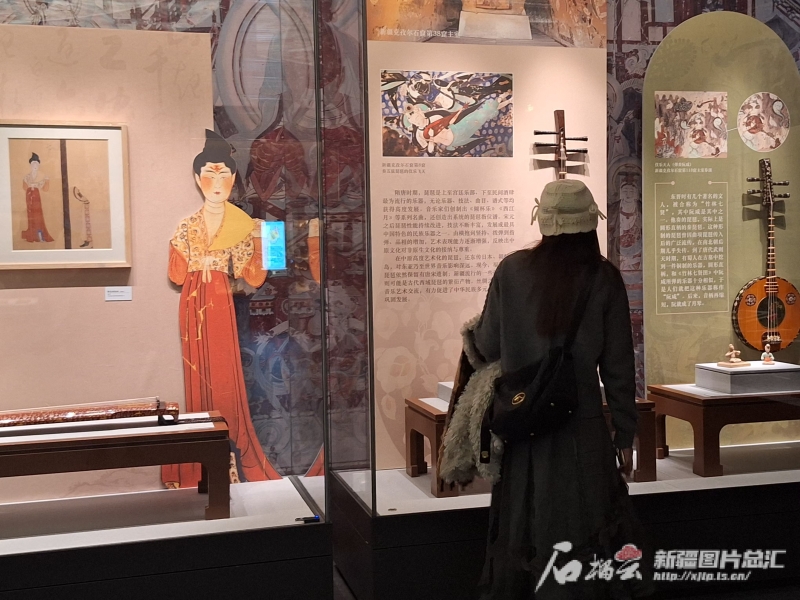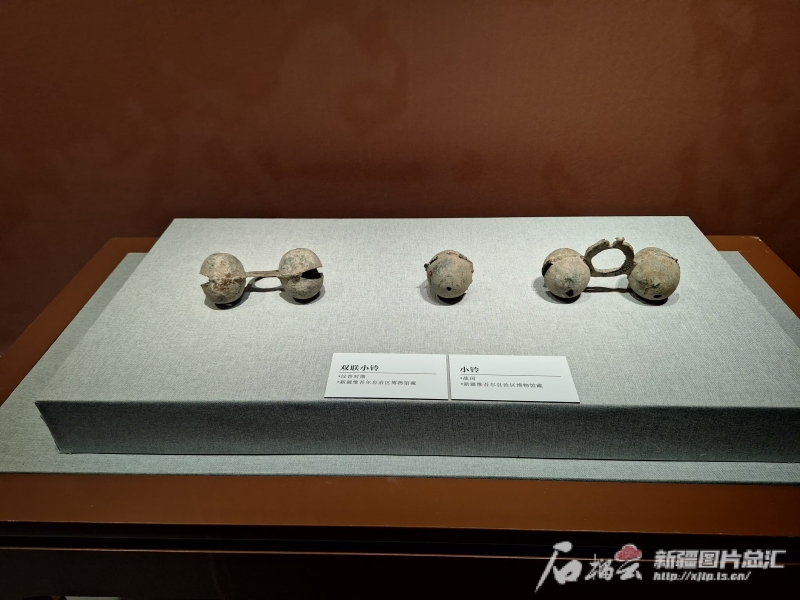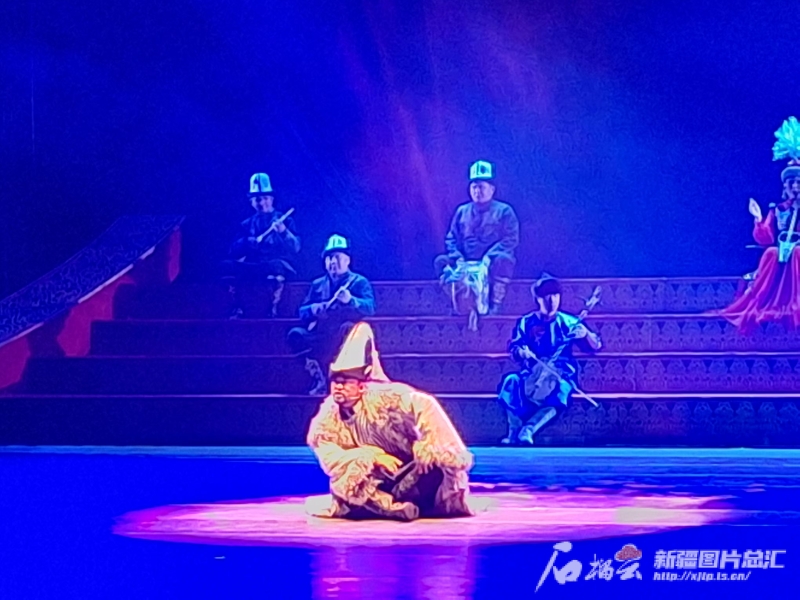Shiliuyun-Xinjiang Daily (Reporter Maygul Aytihazi) news: During the Spring Festival of the Year of the Snake, Xinjiang International Grand Bazaar was bustling with activities and filled with tourists. The big red lanterns hanging high exuded a festive and harmonious atmosphere.
The central square of the scenic area was the liveliest spot in the bazaar. As strains of Xinjiang's traditional music played, dancers moved gracefully, their postures either bold and unrestrained or shy and delicate, with radiant smiles on their faces. Employees from nearby handicraft shops joined in with instruments like hand drums and Suona, a traditional Chinese double-reed woodwind instrument, adding a unique charm to the dance. Tourists from other regions shot or filmed the beautiful scene, with souvenirs featuring traditional instruments like nagra drums and ghijak (traditional Uygur musical instruments) becoming popular purchases.
Xinjiang's musical instruments, as an important part of China's excellent traditional culture, have evolved from ancient alligator drums to nagra and from Huqin (a traditional Chinese string instrument) to ghijak. These instruments demonstrate the inheritance and innovation of traditional Chinese musical instruments in terms of forms, cultural lineage, and artistic expression. As is recorded in the Book of Songs, "When brothers gather, there is harmony and joy. When spouses unite, it is like playing the zither and the lute."

Photo shows a tourist visits the "Silk Road Musical Instruments" exhibition in Xinjiang Museum in Urumqi, capital city of northwest China's Xinjiang Uygur Autonomous Region. (Photo by Shiliuyun-Xinjiang Daily/Maygul Aytihazi)
Inheritance of instrumental civilization through history
During the Spring Festival holiday, Xinjiang Museum was crowded with visitors eager to explore the cultural origins of this land. The new exhibition, "Silk Road Musical Instruments," became a popular attraction for its display of colorful musical and dance heritage.
Entering into the exhibition hall, the first object to catch the eye is a small bell, quietly resting in a display case. It seems to silently narrate its ancient history. This artifact from the Warring States Period is now treasured by the Xinjiang Museum. Along with many other musical and artistic treasures, it once resonated not only in the Western Regions but also across the Central Plains.
"These exhibited instruments bear witness to the musical and dance culture of Xinjiang along the Silk Road from ancient times to the present. They reveal the artistic origins of Xinjiang as the 'Land of Song and Dance' and highlight the extraordinary charm of the history of cultural communication," said Ma Wen, a staff member of the exhibition department of Xinjiang Museum and one of the curators of the exhibition.
Instruments like the Konghou (an ancient plucked stringed instrument) from Yanghai Tombs in Turpan and eagle flute (traditional Tajik musical instrument) exude unique charm, attracting visitors to watch. Some visitors carefully examined the shapes of the instruments, while others listened attentively to the explanations, their faces showing expressions of amazement and awe. The mutual influence and borrowing between the musical cultures of the Central Plains and the Western Regions are well-documented by a guqin model unearthed from the Astana Tombs in Turpan, which is now in the museum's collection.
Guqin, an early plucked string instrument from the Central Plains, is a gem of Chinese culture. In ancient Chinese society, it was a standard expectation that every scholar and gentleman should have a profound mastery of four essential arts: the qin (a plucked string instrument), the game of go (qi), calligraphy (shu), and traditional Chinese painting (hua). This guqin model, made of wood, features an ornate stand divided into five sections, decorated with floral-petal pattern inlaid with turquoise on the top. "Although this model differs from a real guqin, it truly reflects the general appearance of guqin during the Tang Dynasty and its spread in Turpan," said Adil Abliz, a researcher at the Xinjiang Museum.

Photo shows a small bell displayed at the "Silk Road Musical Instruments" exhibition in Xinjiang Museum in Urumqi, capital city of northwest China's Xinjiang Uygur Autonomous Region. (Photo by Shiliuyun-Xinjiang Daily/Maygul Aytihazi)
Modern applications of musical civilization
With the song "Pingguoxiang" (meaning Apple Fragrance) becoming popular, instruments like Dombra (a two-stringed plucked musical instrument important in Kazakh folk culture) and Bayan accordion have gained wider recognition. While the "Silk Road Musical Instruments" exhibition showcases the talents and aesthetic of ancient people, "Pingguoxiang" reflects the ongoing role of various instruments in contemporary cultural life.
Before the Spring Festival of the Year of the Snake, a New Year's Eve gala was held in Peyziwat County, Kashi Prefecture. The erhu solo "Horse Racing" received the most enthusiastic applause from the audience. Ana Hainaili, one of the audience, said, "This performance is so powerful. I feel very happy and proud to appreciate such excellent traditional culture."
In Xinjiang, known as the "Home of Singing and Dancing," music is an integral part of daily life. As night falls, melodious music from square dances in urban parks and Meshrep performed in rural bazaars fill the air. Traditional instruments like pipa, erhu, hand drums, and utar are played skillfully by musicians, telling stories through their tunes.
Music is not only popular in mass culture but also promotes cultural exchanges. The large-scale musical and dance drama "Lift Your Veil – Xinjiang is a Wonderful Land" has been performed on international stages in Kazakhstan, Uzbekistan, and the United Arab Emirates. Programs like "Qiuci Music and Dance," "Joyful Grassland," and "Manas" have captivated audiences. The Qiuci music and dance, along with ethnic instrumental performances, have truly stunned the world.
"Although we don't speak the same language, foreign audiences love our performances and give us enthusiastic applause wherever we go," said Aslibaik Mamatiruz, a dancer from the Song and Dance Troupe of Kizilsu Kirgiz Autonomous Prefecture who has performed in many countries. "I was born in Wuqia County, Kizilsu Kirgiz Autonomous Prefecture, where everyone can sing a few lines of the Kirgiz ethnic epic Manas. I am fortunate to live in modern China, where the economy is rapidly developing, and I can perform on so many wonderful stages."

Photo shows Aslibaik Mamatiruz performs a large-scale musical and dance drama, "Lift Your Veil – Xinjiang is a Wonderful Land." (Photo by Shiliuyun-Xinjiang Daily/Maygul Aytihazi)
Progressive development of musical civilization
Over thousands of years, the rich musical traditions of China have been preserved and enhanced through various efforts. In Xinjiang, villages dedicated to musical instrument production, a comprehensive list of intangible cultural heritage projects, systematic training in professional colleges, and standardized production of ethnic instruments have collectively safeguarded the splendid Chinese musical instrument culture.
In 2000, Tuowankewukusake Vllage in Wukusake Town, Shufu County, Kashi Prefecture, was designated as the "China Xinjiang Ethnic Instrument Village" by the State Council. The village has a history of over 150 years of making instruments in family workshops. Almost every household in the village makes instruments, producing 27 major categories and over 50 varieties that cover all traditional ethnic instruments from Xinjiang. These instruments are sold in major Chinese cities like Beijing, Shanghai, and Guangzhou, and even exported to Central Asia and Europe. The instrument-making industry has truly driven local villagers to prosperity.
As a region with diverse ethnic groups and cultures, Xinjiang has given birth to many intangible cultural heritage treasures through exchanges and integration. In 2008, the Uygur instrument-making technique was included in the second representative list of state-level intangible cultural heritage items. With the continuous enrichment of Xinjiang's cultural heritage protection, inheritance, and utilization, the number of instruments listed in national and autonomous region-level intangible cultural heritage representative lists is increasing.
Elijan Amer lives in a rural area of Payzawat County, Kashi Prefecture. His family has been making instruments since his grandfather's time. His WeChat Moments are filled with instrument-related content, including photos of exquisite instruments and short videos of skill-sharing. "I have my own instrument workshop, where I make dutar and ghijak with my apprentices," he said. "A handcrafted dutar can sell for over 400 yuan, and making instruments has improved my living conditions."
Mastering instrument playing is not just a skill but an art that requires professional training. Qilin, who teaches morin khuur (a traditional Mongolian bowed stringed instrument also known as the horse-headed fiddle) at the Xinjiang Arts University, said, "For the morin khuur major, our institute offers a complete music education system with three levels, including secondary vocational school, undergraduate, and graduate studies."
The making of ethnic instruments has traditionally been passed down orally without a standardized written record. Due to Xinjiang's vast territory, the same instrument may vary in shape and form depending on the region and user. Now, ethnic instrument production in Xinjiang is gradually becoming standardized, with rigorous and detailed regulations on classification, structural components, product quality, materials, sound quality, and inspection methods. This standardization ensures the inheritance and development of traditional ethnic instruments by setting industry standards and norms.
(A written permission shall be obtained for reprinting, excerpting, copying and mirroring of the contents published on this website. Unauthorized aforementioned act shall be deemed an infringement, of which the actor shall be held accountable under the law.)









